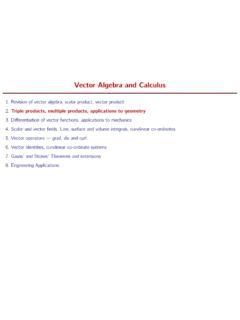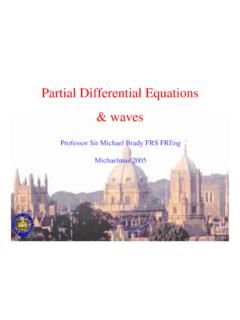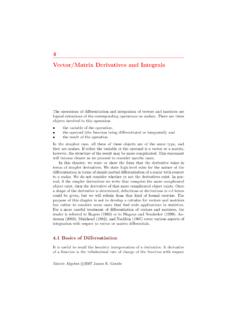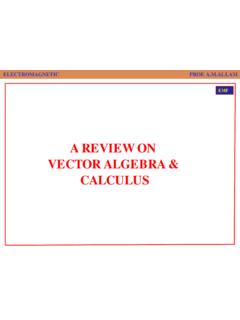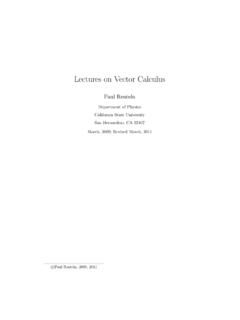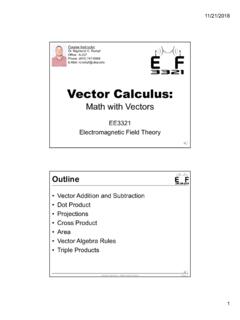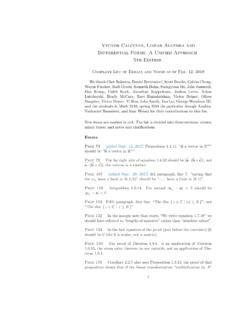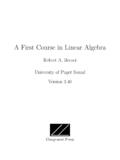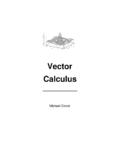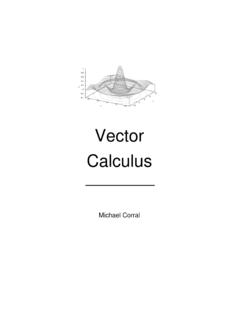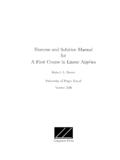Transcription of 2A1VectorAlgebraandCalculus - University of Oxford
1 12A1 vector algebra and Calculus8 Lectures MT 2013 Stephen RobertsRev Oct sjrob/Teaching/VectorsOverviewMany of you will know a good deal already aboutVector algebra how to add and subtractvectors, how to take scalar and vector products of vectors, and something of how to describegeometric and physical entities using vectors. This coursewill remind you about that good stuff,but goes on to introduce you to the subject ofVector Calculuswhich, like it says on the can,combines vector algebra with give you a feeling for the issues, suppose you were interested in the temperatureTof water ina river. TemperatureTis ascalar, and will certainly be a function of a position vectorx= (x , y , z)and may also be a function of timet:T=T(x, t). It is a scalar now that you kepty , z , tconstant, and asked what is the change in temperature as youmove a small amount inx? No doubt you d be interested in calculating T / x.
2 Similarly if youkept the point fixed, and asked how does the temperature change of time, you would be interestedin T / why restrict ourselves to movements up-down, left-right, etc? Suppose you wanted to knowwhat the change in temperature along an arbitrary direction. You would be interested in T x,but how would you calculate that? Is T / xa vector or a scalar?Now let s dive into the flow. At each pointxin the stream, at each timet, there will be a streamvelocityv(x, t). The local stream velocity can be viewed directly using modern techniques suchas laser Doppler anemometry, or traditional techniques such as throwing twigs in. The point nowis thatvis a function that has the same four input variables as temperature did, but its outputresult is a vector . We may be interested in placesxwhere the stream suddenly accelerates, orvortices where the stream curls around dangerously. That is, we will be interested in finding theacceleration of the stream, the gradient of its velocity.
3 Wemay be interested in the magnitude ofthe acceleration (a scalar). Equally, we may be interested in the acceleration as a vector , so thatwe can apply Newton s law and figure out the is the stuff of vector bookVector algebra : scalar and vector products; scalar and vector triple products; geometric appli-cations. Differentiation of a vector function; scalar and vector fields. Gradient, divergence andcurl - definitions and physical interpretations; product formulae; curvilinear coordinates. Gauss and Stokes theorems and evaluation of integrals over lines, surfaces and volumes. Derivationof continuity equations and Laplace s equation in Cartesian, cylindrical and spherical Content Introduction and revision of elementary concepts, scalar product, vector product. Triple products, multiple products, applications to geometry. Differentiation and integration of vector functions of a single variable. Curvilinear coordinate systems.
4 Line, surface and volume integrals. vector operators. vector Identities. Gauss and Stokes Theorems. Engineering OutcomesYou should be comfortable with expressing systems (especially those in 2 and 3 dimensions) usingvector quantities and manipulating these vectors without necessarily going back to some should have a sound grasp of the concept of a vector field, and be able to link this idea todescriptions of various physical should have a good intuition of the physical meaning of the various vector calculus operatorsand the important related theorems. You should be able to interpret the formulae describingphysical systems in terms of this these notes cover the material you need to know you should, wider reading is essen-tial. Different explanations and different diagrams in bookswill give you the perspective to glueeverything together, and further worked examples give you the confidence to tackle the tute sheets.
5 J Heading, Mathematical Methods in Science and Engineering , 2nd ed., , (Arnold). G Stephenson, Mathematical Methods for Science Students , 2nd ed., , (Longman). E Kreyszig, Advanced Engineering Mathematics , 6th ed., , (Wiley). K F Riley, M. P. Hobson and S. J. Bence, Mathematical Methodsfor the Physics andEngineering , 8 and 9, (CUP). A J M Spencer, et. al. Engineering Mathematics , , , (Van Nostrand Reinhold). H M Schey, Div, Grad, Curl and all that , Norton3 Course WWW PagesPdf copies of these notes (including larger print versions), tutorial sheets, FAQs etc will be sjrob/Teaching/Vectors4 Lecture 1 vector VectorsMany physical quantities, such a mass, time, temperature are fully specified by onenumber or magnitude. They arescalars. But other quantities require more thanone number to describe them. They arevectors. You have already met vectors intheir more pure mathematical sense in your course on linear algebra (matrices andvectors), but often in the physical world, these numbers specify amagnitudeandadirection a total of two numbers in a 2D planar world, and three examples are velocity, acceleration, electric field, and force.
6 Below, prob-ably all our examples will be of these magnitude and direction vectors, but weshould not forget that many of the results extend to the widerrealm of are three slightly different types of vectors: Free vectors:In many situtationsonlythe magnitude and direction of avector are important, and we cantranslatethem at will (with 3 degrees offreedom for a vector in 3-dimensions). Sliding vectors:In mechanics the line of action of a force is often importantfor deriving moments. The force vector can slide with 1 degree of freedom. Bound or position vectors:When describing lines, curves etc in space, it isobviously important that the origin and head of the vector are not translatedabout arbitrarily. The origins of position vectors all coincide at an the advantages of using vectors is that it frees much of the analysis fromthe restriction of arbitrarily imposed coordinate example, if two freevectors are equal we need only say that their magnitudes and directions are equal,and that can be done with a drawing that is independent of any coordinate , coordinate systems are ultimately useful, so it useful to introduce theidea of vector components.
7 Try to spot things in the notes that are independent56 LECTURE 1. vector ALGEBRArr23Or1 Free vectorsSliding vectorsPosition vectorsFigure :of coordinate vector elements or components in a coordinate frameA method of representing a vector is to list the values of its elements or componentsin a sufficient number of different (preferably mutually perpendicular) directions,depending on the dimension of the vector . These specified directions define acoordinate frame. In this course we will mostly restrict our attention to the3-dimensional Cartesian coordinate frameO(x , y , z). When we come to examinevector fields later in the course you will use curvilinear coordinate frames, especially3D spherical and cylindrical polars, and 2D plane polar, coordinate : vector a Cartesian coordinate frame we writea= [a1, a2, a3] = [x2 x1, y2 y1, z2 z1] ora= [ax, ay, az]as sketched in Figure Defining , , kkkas unit vectors in thex , y , zdirections = [1,0,0] = [0,1,0] kkk= [0,0,1] bba+ba+bcbab+cc(a)(b)Figure : (a) Addition of two vectors is commutative, but subtraction isn t.
8 Note that thecoordinate frame is irrelevant. (b) Addition of three vectors is could also writea=a1 +a2 +a3 kkk .Although we will be most often dealing with vectors in 3-space, you should notthink that general vectors are limited to three these notes we will use bold font to represent vectorsa, , In your written work,underline the vector symbola, and bemeticulousabout doing so. We shall usethe hat to denote a unit vector equalityTwo free vectors are said to be equal iff their lengths and directions are the we use a coordinate frame, we might say that correspondingcomponents ofthe two vectors must be equal. This definition of equality will also do for positionvectors, but for sliding vectors we must add that the line of action must be vector magnitude and unit vectorsProvided we use an orthogonal coordinate system, the magnitude of a 3- vector isa=|a|=qa21+a22+a23To find the unit vector in the direction ofa, simply divide by its magnitude a=a|a|.
9 vector Addition and subtractionVectors are added/subtracted by adding/subtracting corresponding components,exactly as for matrices. Thusa+b= [a1+b1,a2+b2,a3+b3]8 LECTURE 1. vector ALGEBRAA ddition follows the parallelogram construction of (a). Subtraction (a b) is defined as the addition (a+ ( b)). It is useful to remember that the vectora bgoes following results follow immediately from the above definition of vector addi-tion:(a)a+b=b+a(commutativity) (Figure (a))(b) (a+b) +c=a+ (b+c) =a+b+c(associativity) (Figure (b))(c)a+0=0+a=a, where the zero vector is0= [0,0,0].(d)a+ (-a) = Multiplication of a vector by a scalar. (NOT the scalarproduct!)Just as for matrices, multiplication of a vectoraby a scalarcis defined as multi-plication of each component byc, so thatca= [c a1, c a2, c a3].It follows that:|ca|=p(c a1)2+ (c a2)2+ (c a3)2=|c||a|.The direction of the vector will reverse ifcis negative, but otherwise is unaffected.
10 (By the way, a vector where the sign is uncertain is called a director.) s law states that the electrostatic force on charged particleQdueto another charged particleq1isF=KQq1r2 erwhereris the vector fromq1toQand ris the unit vector in that samedirection. (Note that the rule unlike charges attract, like charges repel isbuilt into this formula.) The force between two particles isnot modified bythe presence of other charged write down an expression for the force onQatRdue vector fromqitoQisR ri. The unit vector in that direction is(R ri)/|R ri|, so the resultant force isF(R) =NXi=1 KQqi|R ri|3(R ri).Note thatF(R) is a SCALAR, DOT, OR INNER Scalar, dot, or inner productThis is a product of two vectors results in a scalar quantity and is defined as followsfor 3-component vectors:a b=a1b1+a2b2+ thata a=a21+a22+a23=|a|2= following laws of multiplication follow immediately from the definition:(a)a b=b a(commutativity)(b)a (b+c) =a b+a c(distributivity with respect to vector addition)(c) ( a) b= (a b) =a ( b)scalar multiple of a scalar product of two Geometrical interpretation of scalar product bBa baAO bdirection of aProjection of b ontoa(a)(b)Figure : (a) Cosine rule.

